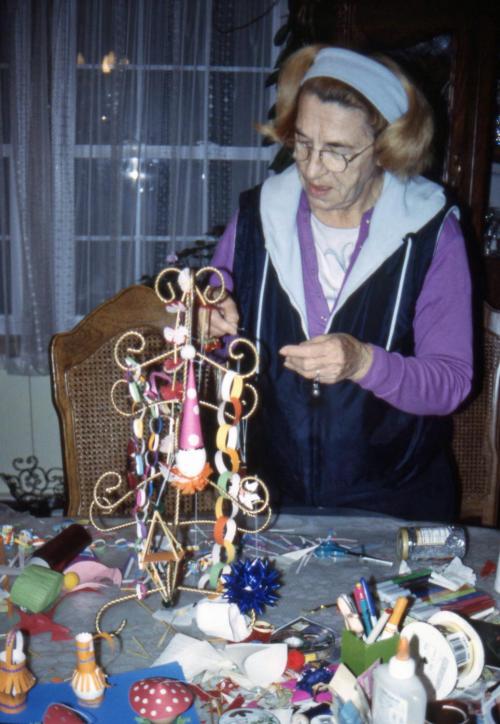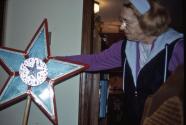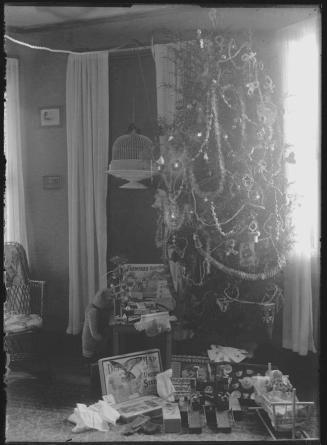Maria Brodowicz’s Polish Ornaments
SubjectPortrait of
Maria K. Brodowicz
(Polish, 1932 - 2018)
Date2000 November
MediumPositive color film slides
ClassificationsGraphics
Credit LineConnecticut Cultural Heritage Arts Program collections
CopyrightIn Copyright
Object number2015.196.1047.1-.6
DescriptionSlide photographs of Maria Brodowicz with Polish ornaments at her home in Wethersfield, Connecticut. Some of the ornaments were made for the "Polonia w Connecticut" exhibition displays.
(.1) Maria making Christmas tree ornaments.
(.2) Icon of Our Lady of Częstochowa in Maria's home.
(.3) Easter wands and pussy willows, traditional Easter decorations.
(.4) Christmas tree ornaments made by Maria.
(.5) The Wigilia star carried by Christmas carol singers.
(.6) Christmas tree ornaments made by Maria.
NotesBiographical Note: Maria K. Brodowicz (1932-2018), of Wethersfield, Connecticut, was deeply committed to her Polish heritage and involved in many aspects of community life. Born in Poland, her early life was disrupted by the Second World War and forced exile. With other members of her family, Maria eventually immigrated to the United States in 1954. She was a member of many Polish-American organizations including the Polish American Congress, Ss. Cyril and Methodius Church in Hartford and the Rosary Society, the Paderewski Choir, and the Polish Cultural Club of Greater Hartford where she often participated in and managed cultural events. Maria was a skilled artist in forms such as sewing, home decorations, and foodways, and she knew many folk traditions and practices, sharing her knowledge with the community. She received the Cavalier Cross Order of Merit Republic of Poland from the president of Poland as well as the Siberian Exiles Cross, and was named Immigrant of the Year in 2017 at a ceremony led by the Secretary of the State at the State Capitol. As her obituary states, “Most special and important to her was her work with the Polish Scouting Organization (ZHP), she was a founding member of the scouts in Hartford and president of the Friends of Polish Scouts (KPH) for thirteen years. As a lifelong scout herself, she achieved the highest rank, and as a leader, was devoted to mentoring the young women in her care.” Maria was instrumental in assisting with CCHAP’s exhibit “Polonia w Connecticut: Polish American Traditional Arts in Connecticut” by creating decorations for the Christmas section of the exhibit and creating an Easter Table as it would be made and decorated in a Polish American home.(.1) Maria making Christmas tree ornaments.
(.2) Icon of Our Lady of Częstochowa in Maria's home.
(.3) Easter wands and pussy willows, traditional Easter decorations.
(.4) Christmas tree ornaments made by Maria.
(.5) The Wigilia star carried by Christmas carol singers.
(.6) Christmas tree ornaments made by Maria.
Subject Note: "Polonia w Connecticut: Polish American Traditional Arts in Connecticut," an exhibition describing the arts and customs of this large community in Connecticut, was developed by CCHAP in collaboration with members of the Polish community, and was displayed in the gallery of the Institute for Community Research (ICR) from December 7, 2000 to May 2001. The project aimed to bring forward the enduring traditions of Polish American communities in Connecticut by conducting fieldwork in these communities, by collecting art works which express community traditions which still are practiced, by presenting an exhibition and related programming to the public and for schoolchildren, and by developing closer ties with the Polish community as ICR was situated in the heart of Hartford’s historic Polish neighborhood. Project partners included the Polish National Home, Ss. Cyril and Methodius Church and School, the Polish Cultural Club of Greater Hartford, the Polish Studies Department at Central Connecticut State University, and a number of community-based local Polish artists and collectors. Marek Czarnecki, an accomplished Byzantine iconographer and scholar from the Bristol Polish community, served as co-curator and gave a gallery talk on March 3, 2001. The project produced a catalogue of exhibit texts and information in both English and Polish. At the exhibit opening, performances were given by the Gwiazdeczki Dancers, a longstanding folk dance group from Saints Cyril and Methodius School and Parish, Hartford, and Wladyslaw Furtak, a singer, storyteller and woodcarver from the Gorale region of Poland who resides in Ansonia. Project funders included the Edward T. and Ann C. Roberts Foundation, the Connecticut Commission on the Arts, the National Endowment for the Arts, and the Polish Studies Dept. of CCSU.
The exhibit was timed to coincide with the annual "szopka contest" in late November when students from schools in New Britain and Hartford would create szopki - traditional Polish nativity scenes - then bring them to Hartford's Polish National Home on Charter Oak Avenue where a panel of judges awards prizes for excellence and creativity during the annual szopka festival. Some of these szopki were included in the CCHAP exhibit. Traditional art forms such as papercutting (wycinanki), painted eggs (pisanki), icons, embroidery, harvest ornaments, Christmas ornaments, and folk costumes all made by Connecticut Poles were featured, and the exhibit also included handmade altars and figures made for devotional use in people's homes, a common Polish practice. The exhibit demonstrated the beauty, usefulness, and continuation of traditional arts specific to the large Polish-American community in Connecticut, while also noting the ways traditions become altered in a new world setting.
Subject Note: Wigilia/Christmas Eve Traditions - The most important holiday of the year, Wigilia marks a time of watching for the birth of Jesus. The weeks of Advent just before and the Wigilia customs themselves focus on setting things in order, following good behavior and being ready and worthy for the gift of the Savior. During the day, people observe a fast; then at the appearance of the first star in the evening sky, families gather for the Christmas Eve supper. Hay is placed under the tablecloth, and often a place is set in anticipation of the Christ child or for an unexpected guest. Opłatek, thin wafers embossed with pictures of the nativity scene and blessed in the church, are broken and shared among everyone at the table. As the head of the household hands one to each person, a greeting such as this is given: "Nie Bóg daj rok doczekacz - May God grant you another year." Sharing opłatek represents the heart of this holiday, when wrongs or bad feelings between people are rectified and positive hopes for the future restored. Wafers are sent to distant relatives and even offered to animals, as they were the first creatures to offer hospitality to Christ. After the opłatek ceremony, an odd number of meatless dishes are served, representing the harvests of fields, gardens, woods, rivers, and orchards. The family sings traditional carols, kołędy, then attends midnight mass, called Pasterka, the shepherds’ mass.
Wigilia traditions persist strongly in Polonia, probably because of their intensely spiritual meaning and the important concepts of reconciliation and salvation that underlie the rituals. The power of this holiday derives from its sense of community and fellowship - every Polish person is celebrating in the same way all over the world. In addition to family Wigilias on Christmas Eve, Polish churches, clubs, and societies hold communal Wigilias and carol singing for their members. The Polish Cultural Club of Greater Hartford has its Wigilia supper this year on December 8. Polish Americans decorate their homes with traditional ornaments made from straw, paper, tin foil, beads, and eggs in the shape of stars or “spiders”, and place these on their Christmas trees.
Subject Note: Święta Wielkanocne/Easter Traditions - As the liturgical calendar year continues after Christmas, Catholics observe the forty days of Lent, a representation of the time of Christ’s suffering. For Poles, reflection, prayer, and strict fasting during Lent is preceded by Tłusty Czwartek, Fat Thursday, when Polish Americans traditionally eat pączki, doughnuts filled with fruit jelly or cream. In Connecticut and Massachusetts Big Y Supermarkets promote pączki extensively during the short time in February when the stores make them. After Ash Wednesday, churches hold a Lenten evening service called Gorzkie Zale, during which sorrowful hymns are sung as a meditation on the passion and death of Christ. As Lent draws to its end, Palm Sunday is marked by woven and braided ornaments of palms representing those carried by well wishers along the route of Christ’s procession through the streets of Jerusalem. Another sign of Easter and the renewal of spring can be seen in the wands made of flowers, straw, colored paper, and pussy willows. Because no church bells ring until Easter Sunday, boys call attention to church services by shaking klekotki, wooden clappers. In a custom unique to Polish churches, a recreation of Christ’s grave is built near the altar; parishioners hold a vigil by the grave, bringing flowers and praying.
Easter itself continues to be an extremely important spiritual celebration in Polonia. Symbols of renewal, resurrection, and new life from both spiritual and agricultural worlds appear everywhere in Easter customs. Polish Americans bring baskets of food to the church on Saturday to be blessed by the priest who sprinkles holy water on them. The baskets are taken home and eaten at the Easter breakfast, święconka, which takes place after the sunrise mass, rezurekcja, and its procession. Easter foods include ham or kielbasa; a sweet bread called babka and a round bread with a cross; butter molded into the shape of a lamb and sugar lambs, symbolizing the sacrifice of Christ; and a horseradish relish which denotes the bitterness of Christ’s suffering. Most significant of all the Easter foods, an egg is divided among all those present at the Easter breakfast table as a symbol of unity, the mystery of life, and fertility. One of the best known Polish traditional arts is pisanki, decorative eggs colored originally with onion skins and other vegetable dyes. Different regional designs of lines, dots, flowers, or hearts are “written” in wax on the eggs with pins; some eggs are decorated with yarn and paper cuttings. As they do with wigilia dinners, many community organizations throughout Polonia hold social święconka for members and those whose families are far away.
Additional materials exist in the CCHAP archive for this artist and these activities.
Cataloging Note: This project was made possible in part by the Institute of Museum and Library Services MA-245929-OMS-20.
Status
Not on view2000-2001 December-March
1905-1924



















